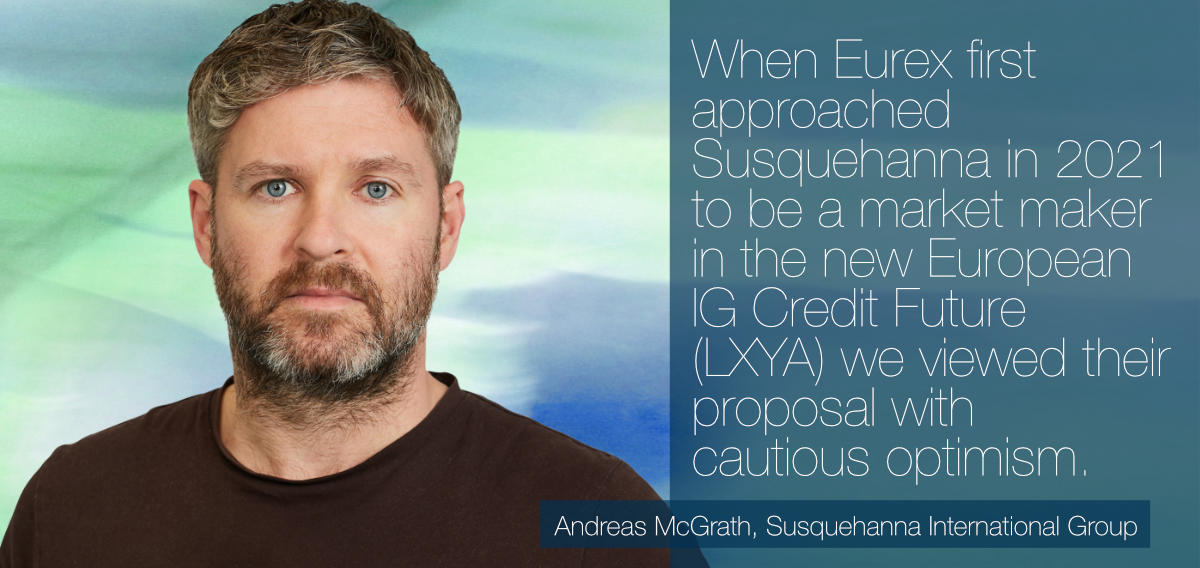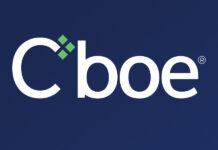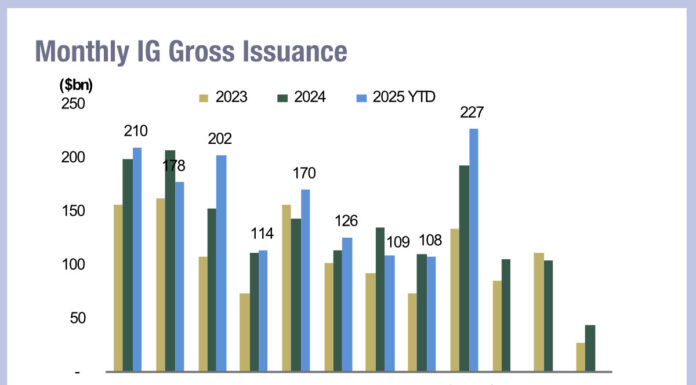By Andreas McGrath, Fixed Income ETF Trader, Susquehanna International Group
How did Susquehanna become involved in this market?
When Eurex first approached Susquehanna in 2021 to be a market maker in the new European IG Credit Future (LXYA) we viewed their proposal with cautious optimism. Although a new product with no established credentials, we believed it had the potential to address unmet needs and attract a broad user base. Having recently emerged from the Covid ETF marketplace, the increased awareness on NAV Premia and Cash/CDS basis had us lean towards expecting this to be a successful product. This intuition has proven correct – from zero, this product now trades ADV EUR130mm per day with over 40 active users.
We were pleased to work closely from the outset of the product with the Eurex Product team, who did an excellent job of promoting and bringing the benefits of the products to the asset management community.
Why do you think the market wants this product now and not in the past?
The need for this type of product became apparent over Covid as an unfunded exchange cleared instrument giving EUR corporate bond exposure would certainly have been useful during that time. There was the divergence between cash and CDS over the 10/2019 – 03/2020 period (EUR HY underperformed CDS by 2% whilst EUR IG underperformed CDS by 5%)1.
Also, EUR Corp ETFs experienced large negative NAV premia (-7.5% in HY/-6.5% in IG with intraday larger)2 which this product could have helped with (due to the NAV expiry feature such discounts can be traded).
Furthermore, the ECB Refi rate (having been at/near zero for over a decade) was due to move significantly higher leading to heightened investor focus on cash balances. For the above reasons, the market conditions were prime to launch a new Delta 1 credit product and explains why perhaps the market had not developed earlier.
How does futures liquidity compare with other credit instruments?
At the launch of LXYA in 2021 the approximate average daily turnover for EUR IG bonds/CDS/Corp ETFs was EUR7.25bn/10bn/1.5bn respectively (IEAC alone trades 300mm+ ADV)3. On our estimates, over 40% of bond flow was electronic at that point. The additional visibility associated with such flow via accurate composite prices and APA trade reports (e.g. TRAX) contributed to heightened price discovery for bonds.
As a result, price formation for futures have coalesced around an orderbook bid/ask of approximately 10 price bps on average with OTC quotes often tighter than this. For comparison the most liquid EUR IG ETF (IEAC LN) has an orderbook bid/ask spread of 6.7 price bps4 with iBoxx TRS significantly wider.
We believe the liquidity in Credit Futures would not be possible without the established Bond/ ETF ecosystem, and that these futures provide a positive feedback loop back into those markets.
How does Open Interest (OI) affect the liquidity?
The liquidity of these Credit Futures in our view is dependent on the underlying market, rather than on the futures wrapper itself.
As long as the bonds trade EUR10bn per day for instance, market makers such as Susquehanna can provide tight prices to their clients. This has meant that interest in this product is independent of the requirement for a minimum level of OI, as it is not an accurate reflection of liquidity levels.
What specifically do futures add to the European credit market?
• Cleared bond index exposure – retain control over cash balances whilst gaining market exposure.
• Trading with repo – Since futures imply a % rate, the difference between ESTR and the % rate contains the implied repo. This might be hard to achieve in other credit products.
• Scalable up and down – LXYA is generally tradable from 1-1000 lots (150k – 150mm) meaning rebals/placeholders/inflows/outflows can be handled more precisely.
• NAV expiry – for users benchmarked at NAV the product will converge to Index NAV on expiry with no premium.
• Fund Mandates – As most fund mandates have preexisting permission for Eurex rates Futures, Credit Futures are normally covered with minimal issues.
• Product control – Cleared and exchange-traded for transparency, potential for Cross Margining. Composition/Look through available via PORT.
• Using Cash [1+r(x/360)] formula helps Spot and Financing comparison across products.5
For iBoxx TRS users, what are the main differences between the products?
Although similar in theory to iBoxx TRS, there are features to Credit Futures that set them apart:
• Cleared (not OTC) – no need for ISDA.
• Official exchange close for marking (not dealer runs).
• 1-legged trade (price and funding expressed in price) as opposed to TRS performance and funding leg.
• On-screen firm markets (there are currently 8 market makers contributing to firm all-day pricing).
• No small size penalty.
How does one trade these instruments and what pitfalls should we be looking out for?
When it comes to Credit Beta, trading should be as straightforward as possible. We think that a 6-month credit future trading at 102 with spot observed at 100 should be easily understood to be trading with a 4% implied rate6. With these observations in hand, one can compare all-in rate to STIR markets to back out implied repo and make cross market comparisons.
This information we feel is beneficial and accretive to the market, which is why Susquehanna has worked with Bloomberg to develop a Fair Value monitor screen on the terminal. As well as contributing to onscreen liquidity, Susquehanna can provide OTC Block trade prices to clients (EUR5mm and above) which also clear and print via the exchange. These quotes can be risk or TAIC (Cash Close/NAV).
What does the future look like for these products?
As noted previously, asset managers looking to replace long/short corporate credit beta have been the early adopters, for some of the reasons I already mentioned. What could the next phase be? One possible evolution is adoption by the 350$bn CTA market7, heretofore unable to trade EUR corporate cash risk.
The third phase, possibly concurrent with Credit Future Options being listed, is CVA/XVA books looking at credit futures as a hedge product (The Basel Committee’s Fundamental Review of Trading Book (FRTB), due to go-live in EU/UK Jan 2025 will test hedges for capital release purposes using data spanning Covid, Ukraine war and REIT/property bond sell-off)8. If the aim of FRTB is to reward volatility reduction on these books, then Credit Futures may provide greater scope for capital release than existing CDS/iTraxx options hedges.
We are excited to have been part of the journey so far, firstly in EUR IG (LXYA) and EUR HY (AHWA) and more recently $EM (XZSA) and £GBP IG (XZRA). We are encouraged by the relatively fast evolution in volume and recently saw a EUR500mm+ day for LXYA onscreen volume.
1. Bloomberg RECMTREU/ ITRXTE5I COMP BEHLTREU/ ITRXTX5I COMP
2. Bloomberg IHYG LN NAV / IEAC LN NAV
3. MarketAxess (TRAX) reporting / DTCC / Bloomberg Field PY508
4. Bloomberg Field PY002
5. www.cmegroup.com/trading/equity-index/fairvalue.html
6. www.cmegroup.com/trading/equity-index/fairvalue.html
7. https://www.barclayhedge.com/solutions/ assets-under-management/cta-assets-under-management/
8. https://www.icmagroup.org/market-practice-and-regulatory- policy/secondary-markets/secondary-markets-regulation/ fundamental-review-of-the-trading-book-frtb/
©Markets Media Europe 2023
©Markets Media Europe 2025













